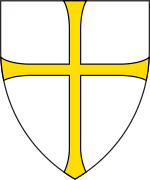Frol
Frol is a former municipality in the old Nord-Trøndelag county, Norway. The 140-square-kilometre (54 sq mi) municipality existed from 1856 until its dissolution in 1962. The municipality was first known as Levanger landsogn and then in 1911 the name was changed to Frol. The municipality included all the area surrounding the town of Levanger in what is now the municipality of Levanger in Trøndelag county.[2][3]
Frol herred Levanger landsogn | |
|---|---|
 Nord-Trøndelag within Norway | |
 Frol within Nord-Trøndelag | |
| Coordinates: 63°41′08″N 11°29′15″E | |
| Country | Norway |
| County | Nord-Trøndelag |
| District | Innherred |
| Established | 1856 |
| Disestablished | 1 Jan 1962 |
| Area | |
| • Total | 140 km2 (50 sq mi) |
| *Area at municipal dissolution. | |
| Population (1962) | |
| • Total | 3,774 |
| • Density | 27/km2 (70/sq mi) |
| Demonym(s) | froling[1] |
| Time zone | UTC+01:00 (CET) |
| • Summer (DST) | UTC+02:00 (CEST) |
| ISO 3166 code | NO-1720 |
| Preceded by | Levanger in 1856 |
| Succeeded by | Levanger in 1962 |
History
The municipality was established as Levanger landsogn in 1856 when the old Levanger formannskapsdistrikt was divided into two municipalities the "town" (kjøpstad) and the "rural district" (landsogn). The two municipalities were named Levanger kjøpstad (population: 1,017) and Levanger landsogn (population: 2,290). On 28 November 1874, two uninhabited parts of the neighboring municipality of Skogn were transferred to Levanger landsogn by a royal resolution. On 13 November 1951, the Lillemarksbakkene area in Frol (population: 51) was transferred to the town of Levanger.
During the 1960s, there were many municipal mergers across Norway due to the work of the Schei Committee. On 1 January 1962, the town of Levanger (population: 1,669) was merged with the neighboring municipalities of Frol (population: 3,774), Åsen (population: 1,939), and Skogn (population: 4,756) to form a new, larger municipality called Levanger.[4]
Government
All municipalities in Norway, including Frol, are responsible for primary education (through 10th grade), outpatient health services, senior citizen services, unemployment and other social services, zoning, economic development, and municipal roads. The municipality is governed by a municipal council of elected representatives, which in turn elects a mayor.[5]
Municipal council
The municipal council (Herredsstyre) of Frol was made up of representatives that were elected to four year terms. The party breakdown of the final municipal council was as follows:
| Party Name (in Norwegian) | Number of representatives | |
|---|---|---|
| Labour Party (Arbeiderpartiet) | 11 | |
| Conservative Party (Høyre) | 1 | |
| Christian Democratic Party (Kristelig Folkeparti) | 2 | |
| Centre Party (Senterpartiet) | 5 | |
| Liberal Party (Venstre) | 2 | |
| Total number of members: | 21 | |
| Party Name (in Norwegian) | Number of representatives | |
|---|---|---|
| Labour Party (Arbeiderpartiet) | 11 | |
| Conservative Party (Høyre) | 1 | |
| Christian Democratic Party (Kristelig Folkeparti) | 2 | |
| Farmers' Party (Bondepartiet) | 5 | |
| Liberal Party (Venstre) | 2 | |
| Total number of members: | 21 | |
| Party Name (in Norwegian) | Number of representatives | |
|---|---|---|
| Labour Party (Arbeiderpartiet) | 10 | |
| Christian Democratic Party (Kristelig Folkeparti) | 2 | |
| Farmers' Party (Bondepartiet) | 5 | |
| Liberal Party (Venstre) | 3 | |
| Total number of members: | 20 | |
| Party Name (in Norwegian) | Number of representatives | |
|---|---|---|
| Labour Party (Arbeiderpartiet) | 10 | |
| Farmers' Party (Bondepartiet) | 5 | |
| Liberal Party (Venstre) | 3 | |
| Local List(s) (Lokale lister) | 2 | |
| Total number of members: | 20 | |
| Party Name (in Norwegian) | Number of representatives | |
|---|---|---|
| Labour Party (Arbeiderpartiet) | 9 | |
| Liberal Party (Venstre) | 5 | |
| Local List(s) (Lokale lister) | 6 | |
| Total number of members: | 20 | |
| Party Name (in Norwegian) | Number of representatives | |
|---|---|---|
| Labour Party (Arbeiderpartiet) | 9 | |
| Farmers' Party (Bondepartiet) | 6 | |
| Liberal Party (Venstre) | 5 | |
| Total number of members: | 20 | |
References
- "Navn på steder og personer: Innbyggjarnamn" (in Norwegian). Språkrådet.
- Thorsnæs, Geir, ed. (2018-03-28). "Levanger landdistrikt". Store norske leksikon (in Norwegian). Kunnskapsforlaget. Retrieved 2018-03-30.
- Thorsnæs, Geir, ed. (2018-03-18). "Frol". Store norske leksikon (in Norwegian). Kunnskapsforlaget. Retrieved 2018-03-30.
- Jukvam, Dag (1999). "Historisk oversikt over endringer i kommune- og fylkesinndelingen" (PDF) (in Norwegian). Statistisk sentralbyrå.
- Hansen, Tore, ed. (2016-05-12). "kommunestyre". Store norske leksikon (in Norwegian). Kunnskapsforlaget. Retrieved 2020-02-02.
- "Kommunevalgene og Ordførervalgene 1959" (PDF) (in Norwegian). Oslo: Statistisk sentralbyrå. 1960. Retrieved 2020-04-14.
- "Kommunevalgene og Ordførervalgene 1955" (PDF) (in Norwegian). Oslo: Statistisk sentralbyrå. 1957. Retrieved 2020-04-14.
- "Kommunevalgene og Ordførervalgene 1951" (PDF) (in Norwegian). Oslo: Statistisk sentralbyrå. 1952. Retrieved 2020-04-14.
- "Kommunevalgene og Ordførervalgene 1947" (PDF) (in Norwegian). Oslo: Statistisk sentralbyrå. 1948. Retrieved 2020-04-14.
- "Kommunevalgene og Ordførervalgene 1945" (PDF) (in Norwegian). Oslo: Statistisk sentralbyrå. 1947. Retrieved 2020-04-14.
- "Kommunevalgene og Ordførervalgene 1937" (PDF) (in Norwegian). Oslo: Statistisk sentralbyrå. 1938. Retrieved 2020-04-14.

